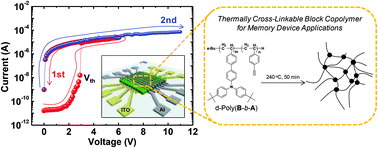Facile anionic synthesis of a well-controlled thermally cross-linkable block copolymer for polymer-based resistive memory device applications
Abstract
The reactivities of 4-[(trimethylsilyl)ethynyl]styrene (A) and 4,4′-vinylphenyl-N,N-bis(4-tert-butylphenyl)benzenamine (B) were investigated by sequential anionic block copolymerization to synthesize a thermally cross-linkable block copolymer for memory device applications. From the investigation on the reactivities of the monomers, the well-defined poly(B-b-A) was synthesized in a simple manner by sequential addition of B as the first monomer and A as the second monomer using the commercially available s-butyllithium (s-BuLi) initiator in THF at −78 °C. The sequential deprotection was then performed to prepare the deprotected polymer (d-poly(B-b-A)) containing the triphenylamine group as the conducting moiety and the ethynyl group as the thermal cross-linker, and the resulting thermally cross-linked polymer was used as an active layer of the memory device. The device fabricated with cross-linked d-poly(B-b-A) exhibited the write-once-read-many times (WORM) nonvolatile memory behavior, which is governed by the space-charge-limited current (SCLC) conduction mechanism and filament formation.


 Please wait while we load your content...
Please wait while we load your content...